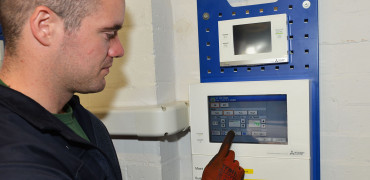Communication in basic terms is a means of sending or receiving information, and if you look back over the past 100 years the modes of communication have changed vastly.
As a Marketing Communications Executive, I guess you could say the study of these modes and how best to communicate with customers should be part of my day to day thinking. And while subconsciously it is, when I really look at it, the evolution of communication – both mass and private is rather interesting.
I started researching this topic a few weeks ago, after my grandmother gave me a small tattered book that she had kept since 1945.
The blue book was a small address book containing all the names and addresses of the women she met while working in the Arsenal during World War II. In fact, without this blue book she wouldn’t have been able to maintain communication with these women after she left.
The main method of private communication during this time was letter writing. In fact on a previous visit my grandmother pulled out a collection of around 100 letters that she had received from my Granddad during his time as a prisoner of war between 1940 and 1945 – highlighting just how important letters during this time really were.
Now however, for the Facebook using generations of Y, millennials and Z, keeping an address book, or even writing a letter, is considered primitive. In fact even my traditionalist grandmother has now ditched the address book, favouring Facebook to keep in contact with her friends.
But will Facebook – and other forms of social media one day be primitive too?
The History of Communications
Mass communication allows topics of awareness to be publicised, and it allows marketers like me to push a message to a target audience.
When looking back, methods like drums, horns, carvings and pictures allowed people to communicate with more than each other both locally and over distance. They were often used to communicate with the spiritual world and with carvings and pictures still being discovered today, this method communicates over time allowing modern man a direct channel into the past.
Jumping a few thousand years (or more) ahead however is the invention of the printing press by Johannes Gutenberg around the 15th century. Although printing was around before this date, it remained expensive and therefore exclusive. The press allowed printing to be mass, thus the printed newspaper as we know it today was born (although in England not till the 17th century apparently!).
Leaping ahead a little bit more, past the evolving postage system, the telegraph and the first fax machine, was the invention of the telephone in 1876. Who knew this invention would evolve to be what it is it today – a small device that the modern generations struggle to prize from their fingertips (although I hasten to add again that my grandmother is an iPhone user). Of course the mobile phones that I’m talking about weren’t introduced until the 1970s and the smart phone until around the 2000s.
Modern Communications
With the arrival and mass adoption of the internet in the 90s, communications all started heading in the same direction which was digital.
For me, as a child of the late 80s, 90s and 00s, my main methods of communication were telephone, mobile, instant messenger, email and social media (mainly Facebook). My first mobile phone was the Nokia 5110 and back then SMS/texting your friends and family almost made the traditional phone call redundant – in fact it was so popular the txtspk language of shorted and abbreviated words was born. Although it wasn’t until the 00s when dial up internet was in its prime that terms like “LOL” took off on MSN Messenger.
My first social media site however was MySpace and I still remember using the comment space to write messages to my friends – although we didn’t really use it for communication per se. What I don’t remember on MySpace however is the advertisements that you get on Facebook now, but as this article from 10 years ago points out, MySpace was quite the marketing tool so I guess it opened the doors to social media marketing as we know it today.
More recently however, the shifts in the age range of users show that different social media networks are popular with different people – in fact if you want to know which site is the coolest, just ask anyone under the age of 16 (apparently it isn’t Facebook!).
But as an actual direct communication only tool WhatsApp and Facebook Messenger are the most widely used across the world. In fact I feel that Snapchat, Twitter, Instagram and now Facebook, which in 2014 moved away from its messenger system and created a standalone Facebook Messenger app, are more visual sharing communication platforms suited to marketing – so I recommend that if you own a company you use at least one of these (after all, everything looks better in sepia, with doggy ears or as a meme!).
Internally however, more and more companies are looking to use WhatApp to communicate better with their staff because of the high adoption between users of all ages – And also because it’s a great way to engage with younger generations in the workforce.
The main method of mass communication when I was younger however was TV. I still remember the breaking news mid-way through TV programs informing everyone at the same time of major event- notably the death of Princess Diana. Now however, we are filtered information at different times depending on the devices that we use – for example there is a noticeable delay from seeing a football goal on TV to receiving the notification on your mobile.
And now following on from what journalists are calling the death of the newspaper, are younger generations going to cause the death of TV?
Platforms like YouTube feed the expectancy that everything we want and need should be immediate and we should have unlimited choice at our fingertips. Live TV just isn’t as popular anymore. Even the major channels are creating their own digital apps (BBC iPlayer was launched in 2007 and ITV Player in 2008).
In fact for marketing, digital TV advertising seems to be a new trend because watching TV on your computer enables the app to monitor your location and other personal details. For example McDonald’s latest digital TV ads locate your closest restaurant.
This has also become a popular way on advertising on smartphones as location data is widely available.
The Future of Communications
So what does the future hold for communications?
There are loads of discussions online where people/influencers, technology companies and marketing agencies are predicting what communications will lead in the future. This article on Ofcom mentions the move to 5G to better carry digital data to our devices – so essentially the thoughts are that more communication and information will continue to be digital so we need technology to better support the loads.
In fact with mobile browsing overtaking desktops for the first time in 2016, the future of communication devices means the traditional computer might not make it into the next decade either.
And of course the buzzword of the past year has been on Artificial Intelligent so that will surely have an impact on our future comms too.
Video also looks to grow even more as a tool of mass and private communication on both the large scale (YouTube) and the smaller scale (Snapchat and the new Instagram stories which launched in 2016). And blogs are continuing to prove very popular – they are even rising in popularity for brands as a platform for thought leadership.
At Mitsubishi Electric we started this blog/content hub to better communicate with the wider world on topics that we think need to be discussed, and we are happy to report back that this is now a key part of our marketing communication strategy.
Final thoughts
For now I don’t think social media is at immediate risk of being seen as primitive, at least not for another 10 years. In fact I think there is still growth in social media and there is still room for new and innovative platforms.
I am however all for the future being visual and portable. A visual blog, a visual website and the increase of quality in visual apps like Instagram will be great. Plus the increase in portable devices with better screens and functionalities (note the recent realise of the iPhone X) will only enhance the communication experience.
As for letter writing or even writing with a pen and paper, the popularity of devices like the iPad Pro which comes with a digital pen, gives us a glimpse into an even more paperless future (especially as printers for smart devices haven’t taken off) – which makes me wonder what the effects on climate change will be… but I’ll leave that for another article.
For more information on the history of communication check out this infographic which mentions other milestones like carrier pigeons, the typewriter and search engines
Ellina Webb is a Senior Marketing Executive at Mitsubishi Electric
If you have any questions about this article, you can contact us via email. Or if you would like to tweet us, please follow our MEUK_LES twitter page.
We upload new articles every week so remember to check back regularly.
You can also sign up for our monthly newsletter below.


